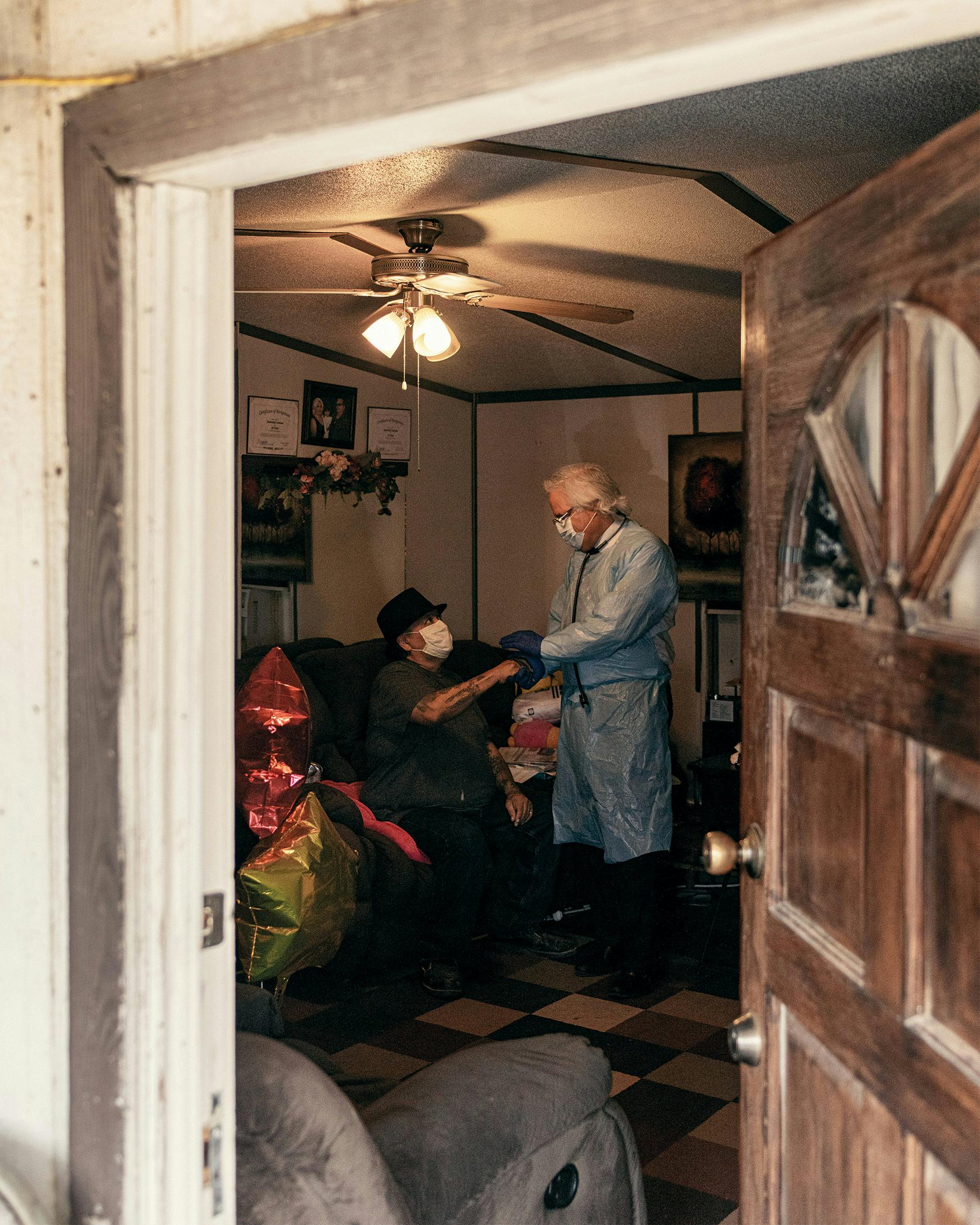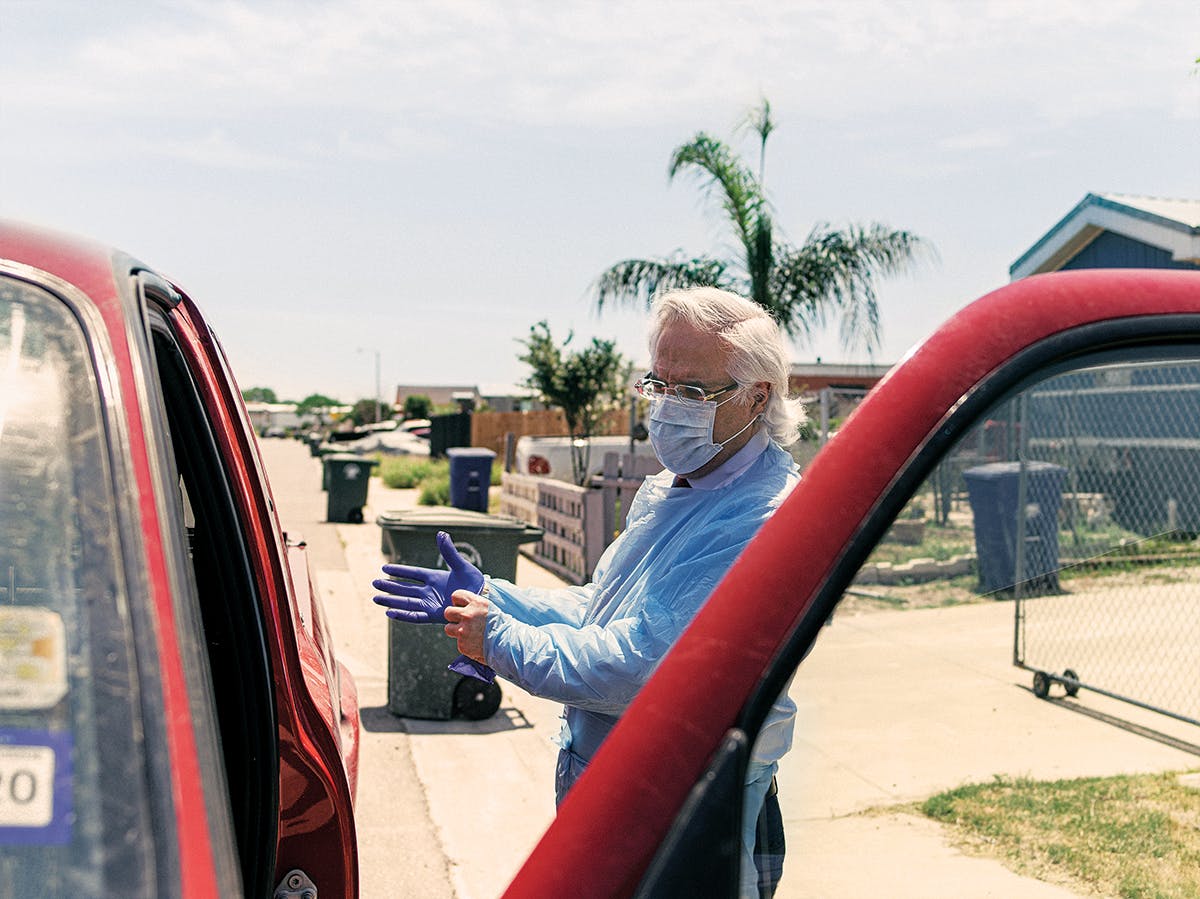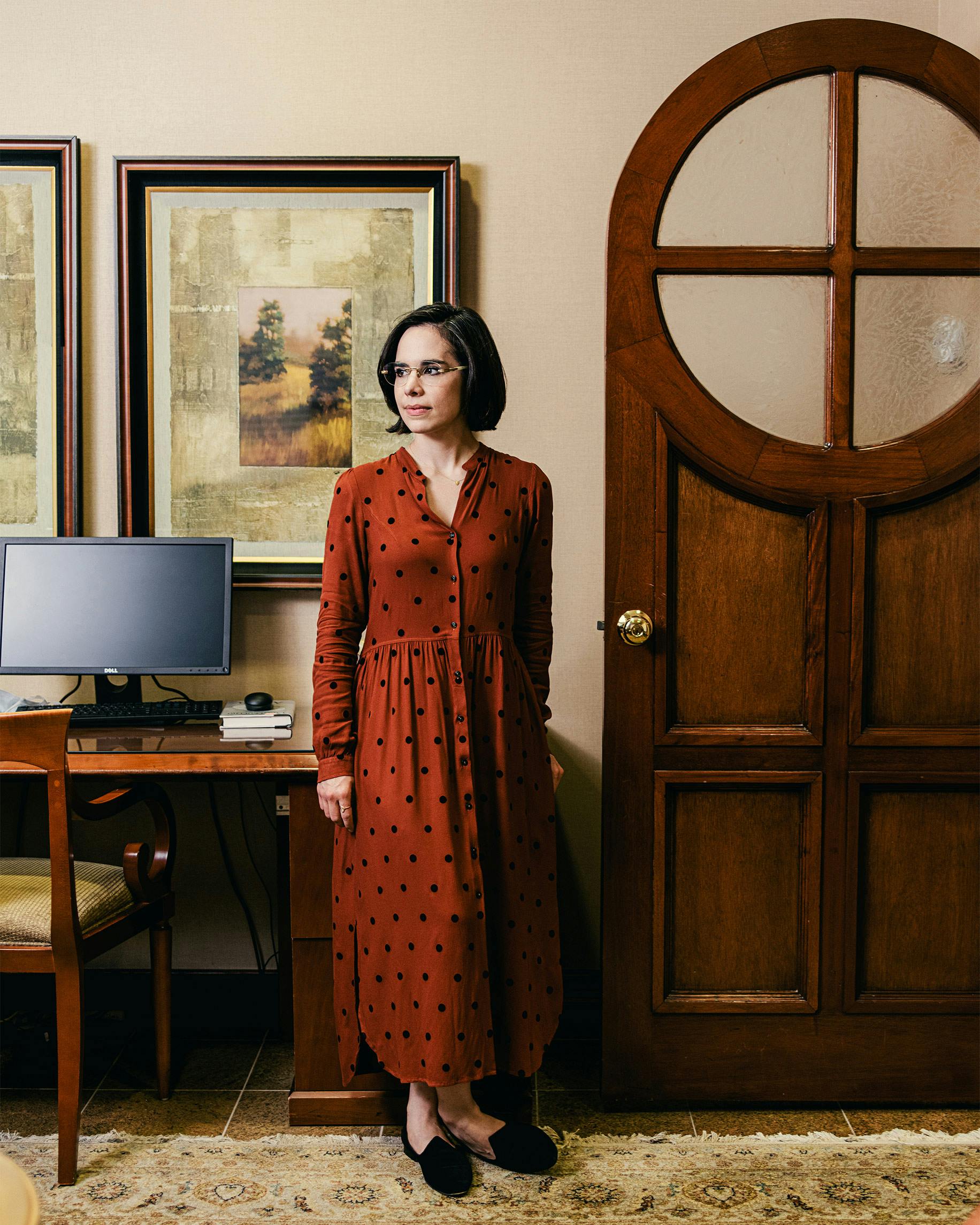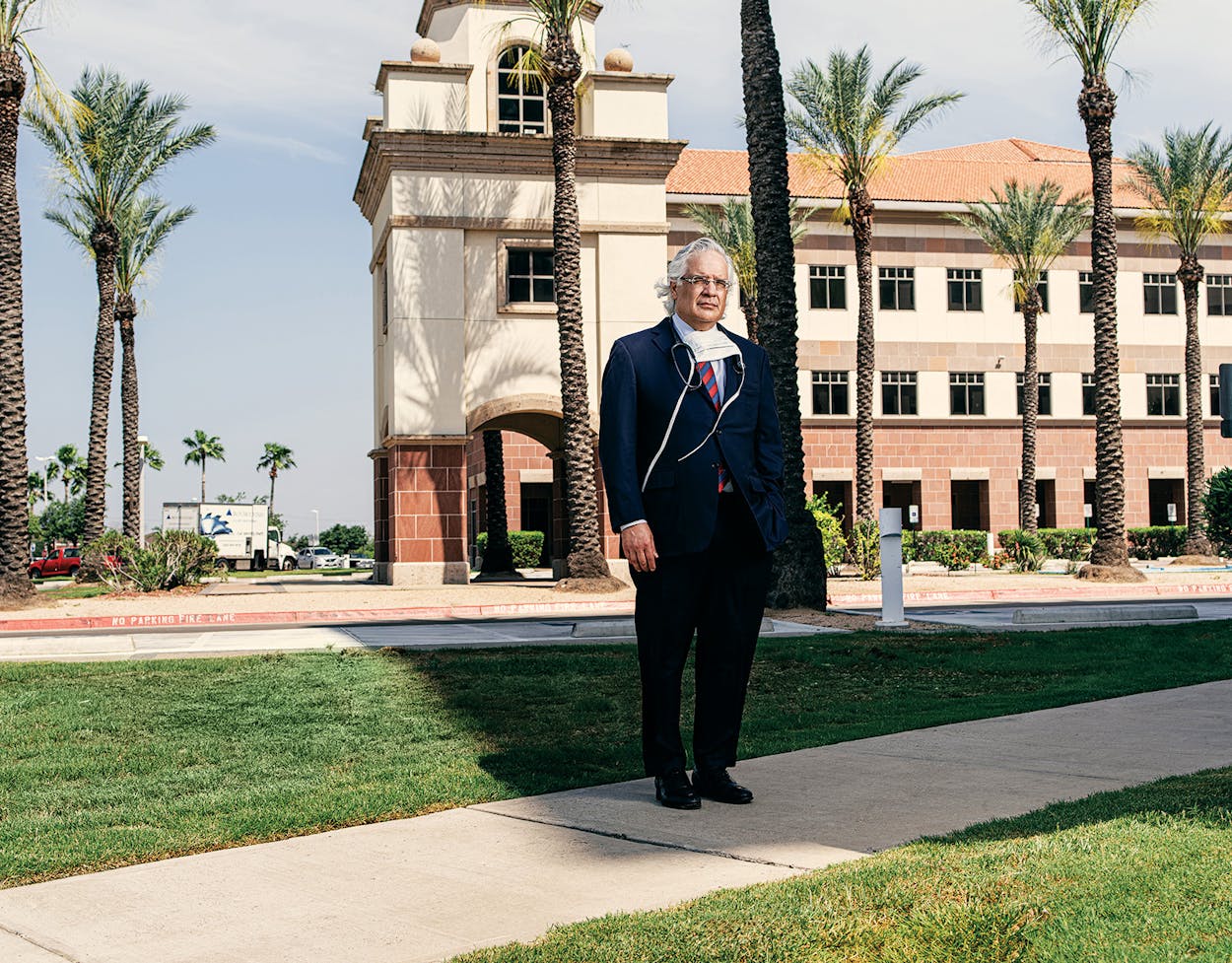On a humid and breezy late April morning in the border city of Laredo, Ricardo Cigarroa, a 61-year-old cardiologist, pulled out of his driveway in a 1999 Toyota Tacoma that he’d christened “The COVID-mobile” and set out to check on self-quarantined patients. Cigarroa knew that some of the house calls that morning would require making life-and-death decisions. Early in his rounds, he parked his truck in front of a south Laredo mobile home; donned a fresh N95 mask, gloves, a gown, and shoe coverings; and knocked on the door. The middle-aged woman inside had called his office to say that she had tested positive for COVID-19 and was now experiencing shortness of breath. Cigarroa greeted her briskly, then checked her oxygen level with a pulse oximeter. It was below 92 percent, the threshold for hospitalization. She needed to get more extensive care immediately, or her condition would likely deteriorate. Within a few minutes, Cigarroa had dressed her in personal protective equipment, escorted her to the passenger seat of the COVID-mobile, and started driving to the larger of the city’s two emergency hospitals, Laredo Medical Center, where Cigarroa often admits his patients.
Other visits that morning required emotional tact as much as rapid medical assessment. When Cigarroa stopped at the house of a local nurse, he found a patient who didn’t look sick at all. Two weeks earlier, she’d tested positive for COVID-19 and dutifully isolated herself at home. Her symptoms improved—“She had corona light,” Cigarroa told me—but when she was tested again to see if she could go back to work, the results showed that she still had the virus. Now she just wanted to see her husband and two children. Cigarroa told her what she already knew: she’d need to stay quarantined for at least another week. “She was quite emotional about it,” Cigarroa said. “I visited with her for about forty-five minutes. I told her that unfortunately, we just have to take it as it comes. We have to be realistic. Remember, you don’t have COVID pneumonia, you’re not in the ICU, you’re not on a ventilator—all those things are phenomenal.”
Cigarroa has about 50 COVID-19 patients he sees in their homes, and they represent a cross section of the heavily Latino city of some 275,000. Sick middle-class nurses whom he’s known for years. Low-income south Laredo residents who saw him talking about COVID-19 on the local news or caught his Cigarroa Clinic ad in the Laredo Morning Times. Cigarroa speaks Spanish during most of his visits and estimates that 60 percent of his patients don’t have health insurance, but he can’t know for sure because he doesn’t bill anyone for house calls. Most refer to him as “Dr. Ricky.”

“It’s remarkable how beautiful a house call is,” Cigarroa said. “You walk into somebody’s home, and immediately you see their world. You know so much about them—their social status, who they live with, the stress of the husband or wife. You see the children not being able to interact. You see the solitude of the patients. And it gives the patients a great sense of relief that they’re not alone.”
When the pandemic began, Cigarroa found himself “with time, all of a sudden.” His cardiology patients were postponing non-emergency visits, so he pivoted his practice to addressing COVID-19. For the first time in his career, he started making regular house calls. Then, when the doctor in charge of Laredo Medical Center’s critical care fell ill with the virus, Cigarroa took on a more central role in the hospital’s COVID-19 intensive care unit: making rounds with patients, strategizing with the hospital’s other doctors about treatment methods, and breaking the news to families when their loved ones died.
But Cigarroa’s work during the COVID-19 crisis has not been strictly medical. Starting in early April, in a series of television appearances on Telemundo and the local NBC affiliate, KGNS, Cigarroa established himself as a kind of Dr. Fauci of South Texas, “dealing hard doses of truth,” in the words of Sergio Mora, the host of the Laredo-based podcast Frontera Radio. Bespectacled with flowing white hair and a calming, deliberately paced baritone, Cigarroa has seized his platform to deliver stark warnings, challenge local health officials, and offer up firsthand stories from the COVID ward at a time when reliable information has felt hard to come by. And Laredoans have paid attention.
“We can’t trust no one anymore,” Priscilla Villarreal, an influential Laredo tabloid news reporter who goes by the moniker Lagordiloca, wrote to her 166,000 Facebook followers on April 13. “It seems to me that the only one being straightforward with us is Dr. Cigarroa!”


In March, during the chaotic and confusing early weeks of the crisis, when local and national leaders from both parties waffled over how to respond, Laredo distinguished itself by acting quickly and decisively. Local officials knew that the city was vulnerable. It has higher rates of poverty, obesity, diabetes, and uninsured residents than the state and national averages, and it is one of the country’s busiest ports, a nexus of trade and human migration, through which as many as 100,000 pedestrians, motorists, truck drivers, and bus passengers cross each day going north and south. “We recognized that we’re the first line of defense for disease coming in from Mexico and we’re the first line of protection for trade continuing in the United States,” Marte Martinez, a physician who serves on the Laredo City Council, told me. “If our port were to fall, our ability to supply the country would be severely damaged.”
Martinez and his colleagues acted early. At an emergency meeting on the evening of March 17, council members voted to pass a stay-at-home order, then the strongest measure in the state. Four days later, they closed public parks. On March 31, as the Centers for Disease Control and Prevention publicly debated whether to reverse course and advise Americans to wear masks, the council members enacted the first mandatory mask policy in the nation, with violations punishable by a $1,000 fine. After there were reports of police breaking up backyard parties, the council also put in place a strict 10 p.m. to 5 a.m. curfew for all residents.
But Laredo’s coronavirus response has been far from frictionless. A local freestanding emergency room brokered a deal in March to buy 20,000 badly needed COVID-19 tests from a Chinese medical company, but the tests turned out to be duds. The city’s health authority, Dr. Victor Treviño, told a newscaster that Laredo had probably experienced its first COVID-19 death, then he publicly backtracked later that night, after the death turned out to be unrelated to the coronavirus. But soon, Laredoans actually did start to die from the disease. By early April, six residents in seven days had succumbed to COVID-19. Suddenly, Webb County, home to Laredo, had one of the highest death tolls in the state, with as many coronavirus-related fatalities as Travis County, which has five times the population. Still, in daily media briefings, city officials told Laredoans not to panic, emphasizing the number of patients who had recovered and the fact that all of the dead had preexisting conditions.

Cigarroa was frustrated by the official response. “It seemed very obvious we weren’t conveying the message effectively enough,” he told me, and he had enough clout to have his opinion heard. Educated at Princeton and Harvard, Cigarroa hails from one of Texas’s great medical dynasties. His father and uncle, Joaquin and Leonides, both doctors, led the effort to bring what is now Texas A&M International University to the city. His older brother, Francisco, a pediatric transplant surgeon, served as chancellor of the University of Texas System. Cigarroa formerly headed the Laredo Medical Group and in 2003 was named Mr. South Texas, a prestigious Laredo civic honor, along with Francisco. In early March of this year, Laredo congressman Henry Cuellar leaned heavily on Cigarroa, who endorsed him, in campaign ads that aired during the final days of Cuellar’s tough primary race against progressive challenger Jessica Cisneros.
Now Cigarroa chose to leverage his reputation to urge Laredoans to take the pandemic more seriously. The low number of positive tests was due mostly to a lack of testing, he thought. “The physicians who were actively taking care of patients, they were saying, ‘My gosh, we have a lot of patients with COVID. We’re having more upper respiratory infections that we’re seeing,’” Cigarroa said. “The sense of urgency in the [city’s] daily briefings wasn’t there.”
On April 6, Cigarroa appeared on the KGNS nightly news broadcast and calmly talked anchor Jerry Garza through the history of pandemics, the city’s horrifying prospects in a worst-case scenario (Laredo had a total of 68 ICU beds, when more than 1,000 could be needed), and the danger Laredoans faced if they defied stay-at-home orders. “What would you do if there was a sniper across the street on top of the roof ?” Cigarroa said. “Would you allow your child, your son, your daughter, your parents to walk out of the house? I don’t think you would. And the virus is everywhere. It’s on top of every house.”

The interview was widely viewed and shared on social media. A few days later, Cigarroa’s daughter, Alyssa, a painter who helps run a local arts organization, decided to start a Facebook page, “Laredo Contra Covid-19,” with a similar goal: to give Laredoans an unfiltered look at what was happening on the city’s medical front lines. On Monday, April 13, Laredo Contra Covid-19 posted a video featuring a local ER doctor ill with COVID-19, who warned, “We are losing nurses and doctors very quickly.” It was viewed 40,000 times within a few hours. That afternoon, Dr. Hector Gonzalez, the director of the city’s health department, addressed the severity of the outbreak in Laredo’s medical community. “Over twelve” health-care providers had tested positive, Gonzalez said, and none were hospitalized.
Cigarroa knew this number was off. He made some calls to get a more realistic tally, and then he released a statement through Laredo Contra Covid-19: Not twelve but more than fifty health-care workers had been infected, and several were critically ill. “Everyone is trying their best,” Cigarroa wrote, “but we must be accurate.”
Cigarroa’s statement had a quick and dramatic effect. The next day, Gonzalez acknowledged at a press briefing that Cigarroa’s number was correct. (Gonzalez told Texas Monthly that the discrepancy was because cases were still under investigation by his staff.) That evening, Cigarroa appeared on newscasts, speaking English and Spanish, to discuss what the city’s medical workers were seeing. By the end of the week, Laredo Medical Center, where most of the infected health-care providers worked, announced that 64 staff members had tested positive for COVID-19, accounting for 20 percent of the city’s overall cases. That Friday, the Texas Department of State Health Services dispatched a team to investigate the outbreak. Two weeks later, on May 1, the city reported that Laredo Medical Center now had 96 staffers and contractors who had tested positive.

When Governor Greg Abbott ordered a partial phased reopening of the state to begin May 1, he preempted local orders, including Laredo’s. After issuing 354 citations for mask violations, Laredo could no longer fine citizens for not covering their noses and mouths, and restaurants were welcome to open their doors with limited capacity, just as they were in every other municipality in the state, from tiny towns with no known cases to big cities with thousands of infections. George Altgelt, the city council member who had pushed most intensely for the city’s mitigation measures, told me that the state and federal governments didn’t really understand the predicament of his border town. “Are we really left to fend for ourselves, but with their rules and little to no support?” Altgelt said.
Still, by that point, the data looked favorable for Laredo. New cases of COVID-19 were declining, likely due, at least in part, to the city’s aggressive measures. Even Cigarroa, who believes there are ten times more cases than the testing numbers indicate, said he thought the public health situation was “manageable.”
But Cigarroa also warned against complacency. On April 30, the night before the state began to reopen, he was back on Jerry Garza’s show to reiterate just how bad the disease could get. He brought along two CT scans. The first showed a healthy person’s clear lungs. The second scan, taken ten days after one of his patients first started experiencing COVID -19 symptoms, was a horrifying image of an infection colonizing a human organ. He wanted Laredoans to understand the “tremendous destruction” the virus could inflict. He had mixed feelings about Abbott’s plan for a phased reopening. On the one hand, he didn’t think it was crazy—at some point, people needed to get back to work. But he also worried that it risked a second wave by opening too quickly. He urged Laredoans to “think for yourself, get as many facts as you can and use common sense. And if you do, you will distance yourself from others. You will use a face mask.”
Then things got weird. The next night, Cigarroa met Alyssa for a late dinner at one of their favorite restaurants, the just-reopened Tacos El Chaparro. The next morning, a grainy cellphone video capturing a few seconds of the Cigarroas’ meal surfaced on Facebook. It had been spliced together with footage from Cigarroa’s April 6 KGNS interview and an internet meme of dancing Ghanaian pallbearers. Priscilla Villarreal, the local news hound known as Lagordiloca, quickly shared it on her personal Facebook page. The implication was clear: the city’s loudest social-distancing advocate was a hypocrite, eating out—unmasked—at the first legal opportunity. But Cigarroa felt the shaming was unfair. “There was no one within twelve feet of us,” he said of the mostly empty restaurant. And by that point in the COVID-19 crisis, he wasn’t issuing blanket advice to just stay indoors. He was urging residents to exercise common sense. He insisted he was doing just that. But the video was jarring, particularly to those who’d praised Cigarroa’s outspokenness. “I don’t know what to think anymore,” said Villarreal. “He is basically saying stay at home, wear masks, and then he goes and does the exact opposite.”
Cigarroa told me he wouldn’t be venturing out to eat again for the foreseeable future. “I’ll be going from the COVID-mobile back to my house for the next two or three months,” he said. He wanted to make clear that he wasn’t taking the disease any less seriously. He was still making his daily house calls, doing his rounds at Laredo Medical Center, and providing updates on Laredo Contra Covid-19. He knew the disease wasn’t going anywhere soon. When I asked how long he figured he’d be treating COVID-19 patients, he replied, “Until the vaccine.”
A version of this article appeared in the June 2020 issue of Texas Monthly with the headline “The Fauci of South Texas.” Subscribe today.
- More About:
- Politics & Policy
- Health








